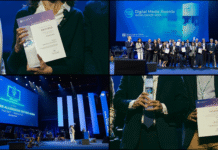Pune-based commercial printer Zaware Creative Enterprises recently installed a 4-color Heidelberg Speedmaster SM 74 with Prinect workflow and a Heidelberg CtP Suprasetter A75. The company, which started with a single-color press in 1999, today converts around three tons of paper per day. The team at Zaware follows well-laid procedures and standard guidelines for the production of multi-color prints of consistent quality. “Standardization of the offset processes coupled with seamless integration of press and prepress is what drives the unit so efficiently,” says Raahhul S Zawarre, executive director of Zaware Creative Enterprises.
Speaking to Indian Printer & Publisher, Zawarre said, “The reason we invested in the Suprasetter A75 and the Prinect workflow is to achieve consistent color quality. The Prinect press reporting application even helps access job reports and other critical information about an ongoing job real-time on smartphones.”
The company runs color calibration on its equipment every three to four months, and also performs regular checks on the pH level of the fountain solution and hardness of blankets. “We have done a lot of things to get the color right and invested in automated software to increase the speed of operation. Today, the speed of work that we have achieved would not have been possible without the Prinect software. The Heidelberg Suprasetter A75 CtP is configured with an online Glunz and Jensen Processor Raptor 85 plus and calibrated with the Epson Sure Color P7000 digital proofer,” shared Zawarre.
Heidelberg Suprasetter A75
The Suprasetter A75 is a flat loading machine with a low power consumption, laser module, made by Heidelberg in Germany. The machine is configured with an online processor and, thus, has minimum touch points. Many of the software provide for the usage of FM screening to avoid the moiré pattern and get the high process color gamut. But the FM screening process is a bit harder to handle on the press with its inherent heavy dot gain, as compared to the AM screening. Hence, Heidelberg’s Prinect Hybrid screening (combination of FM and AM screening) is a much better alternative for most of the jobs.
Ashokan Krishnamoorthy, assistant general manager at Heidelberg India, commented, “Heidelberg supports the standardization of the press and prepress workflows. The aim of Prinect Color Solutions is to optimize the ink settings at the press and control the printing process before and during the print run. This not only helps to achieve a consistent quality but also reduce waste. It can be only achieved by integration of the press into the prepress workflow.”
The CIP4 data from a Heidelberg workflow is populated with more information like paper name, paper size and ink name, apart from the ink coverage area for each zone of the press. This information is transferred to the press and it helps reduce the make-ready time.
The pressroom manager converts the ink coverage value in CIP4 data to precise ink key openings on the press, thus spreading the ink evenly across the entire sheet and reducing waste to an absolute minimum. The parameters are generated by the Prinect Signa Station, Prinect Renderer residing in the Prinect Prepress Manager and Prinect Pressroom Manager Applications.
Additionally, the Calibration Manager in the workflow helps to control the tone value reproduction. Calibration curves consist of linearization and process calibration curves. Process calibrations are created for paper and printing inks to achieve a defined dot gain. The Calibration Manager is responsible for creating the correct calibrations of the plate setter and the printing process. Each set of plates to the press is perfectly color calibrated with the help of the software. Prinect Color toolbox is used for profiling printing and proofing processes.
According to Krishnamoorthy, the color management system developed by Heidelberg helps to integrate a wide range of proofers to the Prinect workflow components like the Renderer to reproduce accurate color and simulate the press, on the particular proof system.


















